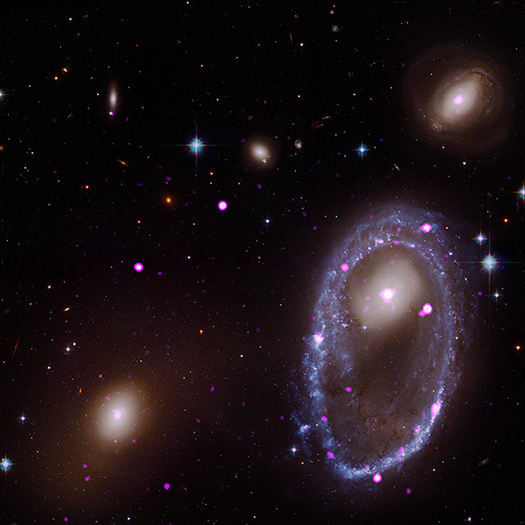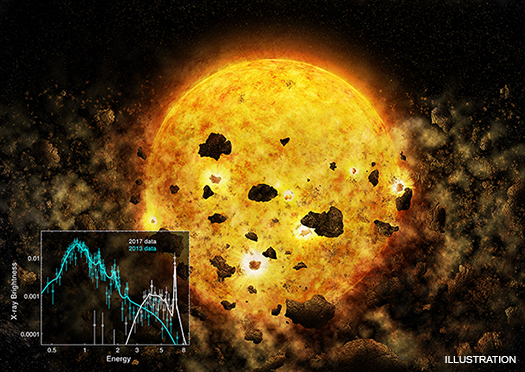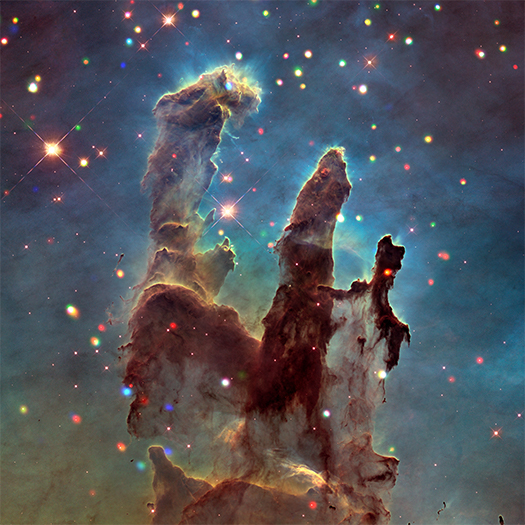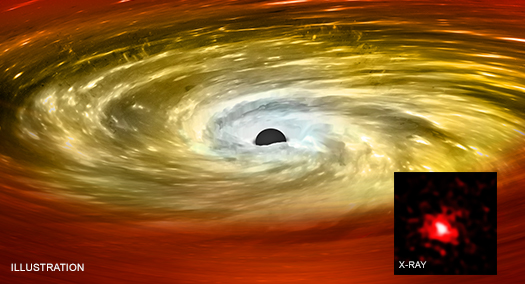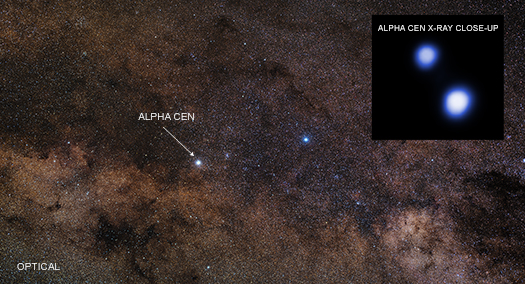Chandra Operations Resume After Cause of Safe Mode Identified
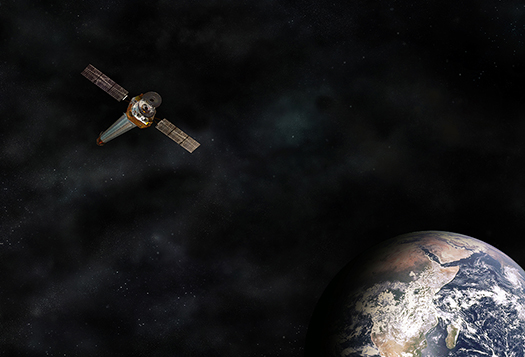
At approximately 9:55 a.m. EDT on October 10, 2018, NASA’s Chandra X-ray Observatory entered Safe Mode, where the telescope’s instruments are put into a safe configuration, critical hardware is swapped to back-up units, the spacecraft points so that the solar panels get maximum sunlight, and the mirrors point away from the Sun. All systems functioned as expected and the scientific instruments are safe.
The cause of Chandra's safe mode on October 10 has been researched and the Operations team has successfully returned the spacecraft to its normal pointing mode. The safe mode was caused by a glitch in one of Chandra's gyroscopes resulting in a 3-second period of bad data that in turn led the on-board computer to calculate an incorrect value for the spacecraft momentum. The erroneous momentum indication then triggered the safe mode. The team has completed plans to switch gyroscopes and place the gyroscope that experienced the glitch in reserve. Once configured with a series of pre-tested flight software patches, the team will return Chandra to science operations which are expected to commence next week.
Below are some questions and answers with additional technical detail, incorporating the latest information as of Monday October 15th, 2018.
Milky Way's Youngest Pulsar Exposes Secrets of Star's Demise
Scientists have confirmed the identity of the youngest known pulsar in the Milky Way galaxy using data from NASA's Chandra X-ray Observatory. This result could provide astronomers new information about how some stars end their lives.
Making Head or Tail of a Galactic Landscape
Astronomers have used data from NASA's Chandra X-ray Observatory to capture a dramatic image of an enormous tail of hot gas stretching for more than a million light years behind a group of galaxies that is falling into the depths of an even-larger cluster of galaxies. Discoveries like this help astronomers learn about the environment and conditions under which the Universe's biggest structures evolve.
Galaxy clusters are the largest structures in the Universe held together by gravity. While galaxy clusters can contain hundreds or even thousands of individual galaxies, the lion's share of mass in a galaxy cluster comes from hot gas, which gives off X-rays, and unseen dark matter. How did these cosmic giants get to be so big?
Cosmic Collision Forges Galactic One Ring — in X-rays
Astronomers have used NASA's Chandra X-ray Observatory to discover a ring of black holes or neutron stars in a galaxy 300 million light years from Earth.
Finding the Happy Medium of Black Holes

Credit: X-ray: NASA/CXC/ICE/M.Mezcua et al.;
Infrared: NASA/JPL-Caltech; Illustration: NASA/CXC/A.Hobart
This image shows data from a massive observing campaign that includes NASA's Chandra X-ray Observatory. These Chandra data have provided strong evidence for the existence of so-called intermediate-mass black holes (IMBHs). Combined with a separate study also using Chandra data, these results may allow astronomers to better understand how the very largest black holes in the early Universe formed, as described in our latest press release.
The COSMOS ("cosmic evolution survey") Legacy Survey has assembled data from some of the world's most powerful telescopes spanning the electromagnetic spectrum. This image contains Chandra data from this survey, equivalent to about 4.6 million seconds of observing time. The colors in this image represent different levels of X-ray energy detected by Chandra. Here the lowest-energy X-rays are red, the medium band is green, and the highest-energy X-rays observed by Chandra are blue. Most of the colored dots in this image are black holes. Data from the Spitzer Space Telescope are shown in grey. The inset shows an artist's impression of a growing black hole in the center of a galaxy. A disk of material surrounding the black hole and a jet of outflowing material are also depicted.
"X"-ploring the Eagle Nebula and "Pillars of Creation"
The Eagle Nebula, also known as Messier 16, contains the young star cluster NGC 6611. It also the site of the spectacular star-forming region known as the Pillars of Creation, which is located in the southern portion of the Eagle Nebula.
Star Shredded by Rare Breed of Black Hole
A new study involving long-term monitoring of Alpha Centauri by NASA's Chandra X-ray Observatory indicates that any planets orbiting the two brightest stars are likely not being pummeled by large amounts of X-ray radiation from their host stars, as described in our press release. This is important for the viability of life in the nearest star system outside the Solar System. Chandra data from May 2nd, 2017 are seen in the pull-out, which is shown in context of a visible-light image taken from the ground of the Alpha Centauri system and its surroundings.
Alpha Centauri is a triple star system located just over four light years, or about 25 trillion miles, from Earth. While this is a large distance in terrestrial terms, it is three times closer than the next nearest Sun-like star.
The stars in the Alpha Centauri system include a pair called "A" and "B," (AB for short) which orbit relatively close to each other. Alpha Cen A is a near twin of our Sun in almost every way, including age, while Alpha Cen B is somewhat smaller and dimmer but still quite similar to the Sun. The third member, Alpha Cen C (also known as Proxima), is a much smaller red dwarf star that travels around the AB pair in a much larger orbit that takes it more than 10 thousand times farther from the AB pair than the Earth-Sun distance. Proxima currently holds the title of the nearest star to Earth, although AB is a very close second.
Chandra Scouts Nearest Star System for Possible Hazards
A new study involving long-term monitoring of Alpha Centauri by NASA's Chandra X-ray Observatory indicates that any planets orbiting the two brightest stars are likely not being pummeled by large amounts of X-ray radiation from their host stars, as described in our press release. This is important for the viability of life in the nearest star system outside the Solar System. Chandra data from May 2nd, 2017 are seen in the pull-out, which is shown in context of a visible-light image taken from the ground of the Alpha Centauri system and its surroundings.
Alpha Centauri is a triple star system located just over four light years, or about 25 trillion miles, from Earth. While this is a large distance in terrestrial terms, it is three times closer than the next nearest Sun-like star.
The stars in the Alpha Centauri system include a pair called "A" and "B," (AB for short) which orbit relatively close to each other. Alpha Cen A is a near twin of our Sun in almost every way, including age, while Alpha Cen B is somewhat smaller and dimmer but still quite similar to the Sun. The third member, Alpha Cen C (also known as Proxima), is a much smaller red dwarf star that travels around the AB pair in a much larger orbit that takes it more than 10 thousand times farther from the AB pair than the Earth-Sun distance. Proxima currently holds the title of the nearest star to Earth, although AB is a very close second.



